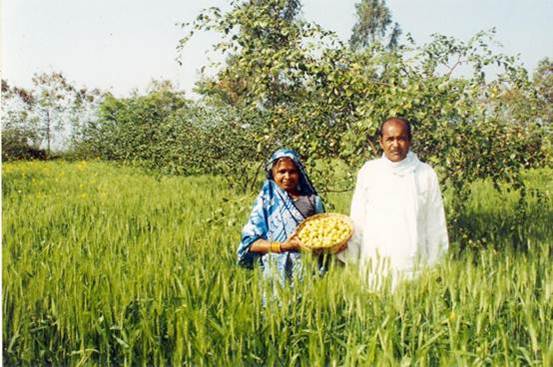|
Agroforestry for Food and
I ndian agriculture is facing diverse challenges and constraints due to growing demographic pressure, increasing food and fodder needs, natural resource degradation and climate change. Agroforestry which has traditionally been a way of life and livelihood in India for centuries has a huge potential in ensuring that farmers enjoy a constant flow of income due to diversification of production. Agroforestry is a land use system in which woody perennials such as trees and shrubs are grown along with crops thus reducing dependency on one crop variety and increasing the farmers’ livelihood opportunities. Now with technological interventions, it is contributing significantly in land use and farm income diversification, natural resource management and meeting the demands of fuel, fodder and timber, thus helping in economic transformation of the farmers.
Various agroforestry practices indicate that the safest choice of tree species should come from native vegetation, which have a history of adaptation to local precipitation regimes. There are a number of tree and crop combinations, which suit the different climate and soil fertility of various regions in the country. Agroforestry systems on arable lands envisage growing of trees and woody perennials on terrace risers, terrace edges, field bunds as intercrops and as alley cropping. It has been demonstrated that agroforestry practices can also be utilised for the rehabilitation of non-arable degraded lands such as bouldery riverbeds, torrents, shifting cultivation areas and waterlogged soils and also in the control of desertification, mine spoil reclamation and treatment of saline and alkaline lands. Major policy initiatives have emphasised the role of agroforestry for efficient nutrient cycling, nitrogen fixation, organic matter addition and underlining the need for diversification by promoting integrated and holistic development of rain fed areas. The Task Force on Greening India for Livelihood Security and Sustainable Development of the Planning Commission (2001) has recommended that for sustainable agriculture, agroforestry should be introduced in an area of an additional 28 million hectares of land in the country. For this purpose, 10 million hectares of irrigated land which is suffering from water logging, salinity and water erosion and another 18 million hectares of rain fed land has been ear marked for agroforestry development. This will ensure ecological and economic development and provide livelihood support to about 350 million people across India. In an encouraging development, the National Mission on Greening India has targeted 3.0 million hectares of degraded agricultural land and fallows to be brought under agroforestry. Long term drought management strategies aim at providing drought mitigation measures through proper irrigation scheduling, soil and water conservation and diversified cropping patterns including agroforestry interventions. Agroforestry increases livelihood security and reduces vulnerability to climate and environmental change. There are ample evidences to show that the overall biomass productivity, soil fertility, soil conservation, nutrient cycling, microclimate improvement and carbon sequestration potential of an agroforestry system is generally greater than that of a conventional agricultural system based on annual crops. The launch of the ‘National Agroforestry Policy’ to mainstream the growing of trees on farms to meet the development and environment related goals recognises that a major role for agroforestry will be in the domain of environmental services. The policy envisages for the development of a mechanism to reward the rural poor for environmental services such as biodiversity conservation, watershed protection and carbon sequestration that they provide to the society by practicing agroforestry. Therefore, a strategy to formulate ‘ecosystem service pricing’ needs urgent attention as agroforestry systems have long gestation periods and majority of the farmers in India are small scale farmers who need quick and regular income from any venture. Such a system of ‘ecosystem service pricing’ will help in the faster adoption of agroforestry and in turn conserve natural resources. This can be done through carbon trading, surface water availability reward etc. q Dr. S.K Dhyani, Director
|